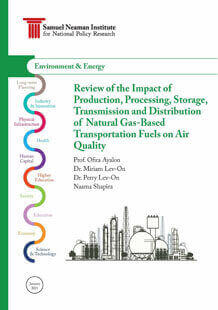גז טבעי אינו נעדר השפעות סביבתיות הן על האוויר (פליטת מזהמי אוויר קונבנציונליים וכן פליטת גזי חממה) והן על הסביבה הימית. לכן נדרש לאסדר פליטות אלה, להגביל אותן בהיתרי פליטה, לנטר ולפקח על ביצוע התקנים. האסדרה, הפיקוח והאכיפה נדרשים לא רק באסדת ההפקה, אלא לכל אורך שרשרת האספקה, לרבות, צנרת הולכת הגז וייצור תחליפי הדלקים.
מחקר זה מהווה המשך לשתי עבודות קודמות שביצע מוסד שמואל נאמן:הראשונה עסקה בסקירת דרכים להערכת פליטות מתאן ממגזר הנפט והגז הטבעי ושיטות מיטביות (חישוביות ואמפיריות) לכימות, והשנייה כללה סקר היתכנות לאומדן הפחת של גז טבעי בשרשרת האספקה מהבאר לרכב עבור דלקים מבוססי גז.
עבודה זו סוקרת את זיהום האוויר הנוצר לאורך שרשרת האספקה של הגז הטבעי מהבאר למיכל הדלק (Well-To-Tank – WTT), החל מהפקה והעלאת לחץ הגז לשם העברתו (מעלה הזרם, (upstream, עיבוד, אחסון, הולכה וחלוקה של הגז (midstream) ועד להפקת תחליפי נפט לתחבורה מבוססי גז טבעי ]חשמל או גז טבעי דחוס (גט”ד), [downstream, אך אינה כוללת את הפליטות מתוצאה משימוש בכלי הרכב עצמם, המונעים בתחליפי דלק אלו (Tank-To-Wheel – TTW).
מזהמי האוויר הקשורים במערכות של גז טבעי כוללים שורה של מזהמים אשר חלק מהם מקורם בפליטות מוקדיות ושאינן מוקדיות של הגז עצמו, וחלקם נובעים מתהליכי העיבוד של הגז הכוללים שימוש במנועים, מדחסים וכד’, כאשר סוג הדלק המשמש להנעתם משפיע על פליטת המזהמים.
מקטע הייצור וההולכה – נמצא כי עיקר פליטות מזהמי האוויר נובעות מציוד, כגון, מדחסים, מנועים וכד’. כמו כן, קיימות דליפות (מוקדיות, המתרחשות בעיקר בעת הורדת לחצים בקווים לפני פעולות תחזוקה, וכן פליטות לא מוקדיות) מהציוד ומהצנרת וכן פליטות כתוצאה מפעולות נישוף ונישוב לכל אורך שרשרת האספקה.
מקטע הפקת תחליפי דלקים – אין בישראל מידע זמין לגבי הפקת ותדלוק כלי רכב בגט”ד. לעומת זאת, בכלי רכב המונעים בחשמל בלבד אין פליטות כלל במקטע השימוש, והפליטות ממקטע ההפקה תלויות במידה מכרעת בתמהיל הדלקים לייצור החשמל.
הערכת תוספת פליטות מרכבי גט”ד – חישוב הפליטות נעשה באמצעות מקדמי הפליטה של מודל ה-GREET האמריקאי (ניתוח כזה אינו יכול להחליף ניתוחי עומק שיש לבצע על נתונים אמיתיים בשוק הישראלי לאחר שהנעה בגט”ד תהווה חלק משמעותי מהשוק). תוספת פליטות צפויה בשנת 2030 הינה של כ-155, 636 ו-494 טונות חומרים אורגניים נדיפים, תחמוצות חנקן ופחמן חד חמצני, בהתאמה.
פליטות מהנעה חשמלית – נעשה חישוב תוך שימוש במקדמי פליטה המתבססים על דיווחי כל יצרני החשמל למפל”ס בשנת 2018, עם התאמה לתמהיל הדלקים העתידי הצפוי על פי רשות החשמל ומשרד האנרגיה. תוספת פליטות צפויה בשנת 2030, בתרחיש ה’שאפתני’, הינה כ-12, 555 ו-258 טונות חומרים אורגניים נדיפים, תחמוצות חנקן ופחמן חד חמצני, בהתאמה.
המלצות:
מניעה וצמצום: קביעת רשימה של מזהמי אוויר מסוכנים שכל היתרי הפליטה יחוייבו לטפל בהם; קביעת הנחיות רגולטוריות לצמצום פליטות בהתאם למאפיינים הייחודיים של כל מתקן ומתקן; קביעת הנחיות לכל חלקי שרשרת האספקה של גז טבעי, כולל הפקה, הולכה ודחיסה, חלוקה ותדלוק; יישום ההנחיות בפועל על ידי שימוש בטכנולוגיות מיטביות, כולל שימוש בתוכניות לאיתור ותיקון דליפות (LDAR); קביעת חובת הכנת תוכניות מפורטות להתמודדות עם מצבי חירום, כולל נהלים להטמעתן בתוך הארגון.
ניטור פליטות: קביעת תוכניות ניטור מפורטות, כולל סוגי הציוד המנוטר, שיטות הבדיקה, תכיפות הניטור, וכיול אמצעי הניטור.
דיווח על הפליטות: דיווחים מקוונים להגברת השקיפות והזמינות לציבור, וכן דיווח שנתי כולל, לרבות דיווחים בזמן אמת ובדיעבד על תקלות; דיווח על כל המתקנים בים וביבשה לכל אורך שרשרת האספקה. בנוסף על דיווחי חובה, קיימות אפשרויות גם לדיווחים וולונטריים, מעבר לנדרש על פי חוק.
מעקב ובקרה: הגשת דו”חות תקופתיים לרגולטור לצורך בדיקת העמידה בתנאי היתר הפליטהה; הגשת דיווחים נוספים בגין כל פעילות של השבתה, התנעה או תחזוקה אשר גורמת לפליטות עודפות והצעדים שננקטים בכדי להפחיתן; אכיפת היישום התקין באופן נחוש על ידי הרגולטור ופרסום כל פעילויות האכיפה שבוצעו באופן שקוף לציבור. יש להבטיח שעלות אי העמידה בתנאים תהיה גבוהה מעלות העמידה בהם.
המלצות נוספות כוללות אימוץ אסטרטגיות נוספות (מחייבות, כמו גם וולונטריות) העולות במדינות העולם על מנת לשפר את הביצועים הסביבתיים של חברות בכלל ושל חברות הגז ושרשרת האספקה בפרט, חיוב דיווח לא פיננסי ו/או תוכניות סביבתיות מרצון.












